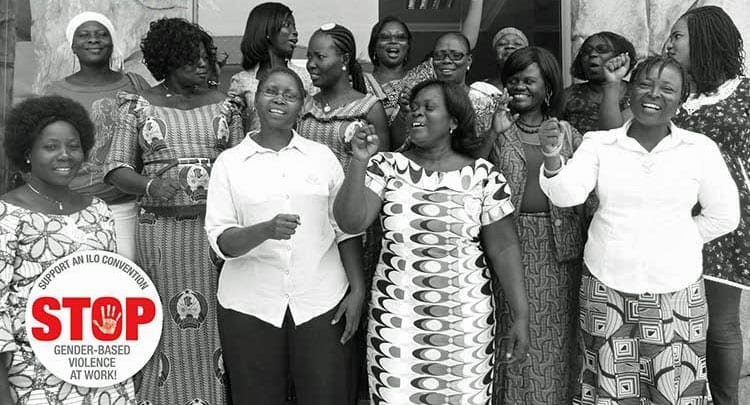No global data document gender-based violence at work. But across the board, gender-based violence remains one of the most tolerated violations of workers’ human rights. Some 35 percent of women over age 15—818 million women globally—have experienced sexual or physical violence at home, in their communities or in the workplace.
The Solidarity Center and allies throughout the international labor, human and women’s rights communities are campaigning for an International Labor Organization (ILO) convention to stop violence and harassment at work. As part of the process, begun many months ago, the International Trade Union Confederation (ITUC) is now spearheading efforts to lobby governments and employer organizations around the world for their input and support. (The ITUC campaign toolkit includes talking points, resources and tips for lobbying your government.)
Allies are building awareness for passage of a convention and distributing an ILO questionnaire to their government representatives soliciting comments and support in advance of a September 22 deadline. When ILO member states ratify a convention, they commit to applying it in national law and practice, and complaints can be made against countries for violations. In June 2018, the ILO International Labor Conference (ILC) will take up the issue.
Gender-Based Violence: Worse Without Freedom to Form Unions
Domestic workers, whose isolation in employer homes makes them especially vulnerable to abuse, are strongly championing its passage. Building on the tactics of their successful global campaign for the 2011 ratification of ILO Convention 189 covering domestic workers—the last convention the ILO passed—they are reproducing those steps to ensure support for a convention to end gender-based violence at work, says Elizabeth Tang, general secretary of the International Domestic Workers Federation (IDWF).
“Gender-based violence is always worse when there is no freedom of association,” Solidarity Center Policy Director Molly McCoy said earlier this year. “When workers are not organized (in unions), they don’t have resources to tackle gender-based violence.” McCoy moderated a Solidarity Center panel in New York on gender-based violence at work in conjunction with the United Nations Commission on the Status of Women meetings.
Gender-Based Violence Includes Physical, Mental Abuse
In a detailed report issued in advance of the 2018 ILO conference, the ILO describes gender-based violence as affecting both women and men, but notes that unequal status and power relations in society and at work often result in women being far more exposed to violence and harassment, which can be physical, psychological and sexual.
In addition, the ILO uses the term “world of work” for a proposed convention, because gender-based violence occurs not only in the physical workplace, but during the work commute, at work-related social events, in public spaces—the primary venue for informal workers such as street vendors—and in the home, in particular for domestic workers and teleworkers.
Addressing violence and harassment through an international standard is key to the objectives of achieving decent work for all and addressing gender inequality in the UN’s 2030 Agenda for Sustainable Development (Goal 8 and Goal 5). A new standard would be preventative, by addressing negative societal and workplace cultures, and “should also be able to respond to the new challenges and risks which might lead to violence and harassment in the world of work, such as those arising from changing forms of work and technology,” according to an October 2016 report by the UN Meeting of Experts on Violence against Women and Men in the World of Work.

